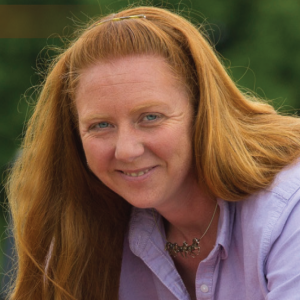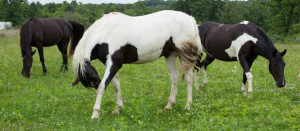
Horsing Around with Rotational Grazing
Patty Winheim
Johnson County, IL
Patty Winheim bought a farm in Johnson County five years ago. The land includes 19 grazing acres and two ponds, a homestead, and a wooded wildlife refuge. A smaller pond, located in the middle of the fields, is fenced off from livestock and a larger pond sits closer to the house and lies adjacent to the wildlife area.
Patty grazes six horses—five of which she raised since birth— and calls them her children. They are Spotted Walking Horses, a double registered–Tennessee Walking Horse & a Spotted Saddle Horse. Patty comes from a family with a tradition of raising and farming with horses, starting back in the 1800’s. Patty has been riding since she was two years old.
Patty has a total of eight pastures, all subdivided for grazing. The four pastures in the back of the farm are used for winter grazing and feeding. Those pastures get ‘muddied up’ since the horses are in them during Southern Illinois’ wet seasons. After resting all winter, her front four pastures are lush and ready to be grazed when spring arrives.
When they purchased the farm, the land had not been touched. “The people I bought it from were kind of naturalists,” she said. The acres weren’t farmed or fenced, just left wide open. They had the neighbor come over once a year to make hay off it but didn’t graze it or use any kind of active management. “I try to limit the amount of chemicals I use,” Patty said. “I am not completely organic, but I try to limit chemical usage as much as possible.”
A lot of the existing brush in her pastures included Autumn Olive trees and the horses love it. They chew the bark, and after repeated chewing, it kills the tree. “It’s pretty amazing how much the horses have taken care of a lot of the brush for me. I think my horses are part goat!”

Patty has identified other species of Tall fescue, Orchard grass, ladino clover, red clover, big bluestem, little bluestem, Indiangrass, broom sedge, bluestem, and paspalum growing in the pastures. The horses like the clovers best and graze the grasses afterwards. The last grass they graze is Tall fescue and broom sedge. Endophyte concerns are not an issue with horses like it is with cattle and their hoof issues. “There is an issue, however, if you are breeding horses. They should be pulled off fescue at least 90 days before the mare foals,” Patty said.
Patty works for USDA’s Natural Resources Conservation Service (NRCS) as a Resource Conservationist. She supports farmers and landowners to develop both conservation and grazing plans so it was only natural she create one for her own horse operation. Her pasture rotation is designed to address her animal’s health. They are older horses and do not need to put on weight like younger stock. “The horses are overweight now and it is a challenge to balance the grazing rotation.”
When rotating the horses to different pastures, Patty’s rule of thumb is to move them roughly once a week—but it depends on the year. She limits how much lush pasture she gives the horses. Spring and early summer can be a real problem. Soon after she moved to the farm, one horse came down with “Founder,” a disease caused from eating rich food. It causes painful hoof problems. “So when rotation should be faster for the grasses sake, I have to slow it down for the health of the animals,” she said. The shortest she ever grazes a pasture is a five-day rotation. This strategy provides longer rest periods for her pastures.
When talking about horse grazing systems, Patty says it’s important to consider creating a ‘sacrifice area’ or what NRCS calls a Heavy Use Area conservation practice. “With their hooves and shoes, horses can really tear up fields when it’s muddy—even more than cattle do,” adds Patty.
Patty is considering reseeding her pastures in the future. If she does decide to seed the fields, she hopes to experiment with cover crop species rather than clover, which she has plenty of already. By using the right cover crop mixtures, the plants could extend her ability to graze through January without causing health problems for the horses.
As part of improvements to her home operation, she installed watering facilities herself. She connected these facilities to the water system from her house, to ensure her horses drink clean, quality water. Most of the pipelines are permanent waterlines connected to troughs that service multiple paddocks. The grazing system is designed to let her move gates that allow horse access to the watering system. The four back paddocks share one watering trough, two other fields share another trough. Her long-term plan is to place a permanent tank in each field instead of using a hydrant and portable tank.
Like many livestock operators find, December can be challenging. Patty tries to keep the horses on grass, but supplements their feed with hay when needed. So far, she’s let them graze grass from April through November and into December, when conditions are good. Then she moves them to the back four pastures for winter.

Because her pastures are lush, her soils—even on sloping ground—are covered and well protected. Even without a soil test, Patty feels confident her soils are healthy. She stockpiles and composts manure collected from two stalls on the farm and has even seen dung beetles out in the fields—always a good sign! From a soil health perspective, she feels her pastures are ok, but she still wants to perform soil tests to be sure. Patty keeps a soil probe in her car so she can go and get samples to test at any time. She typically watches levels for lime, phosphorous, and potassium.
Future plans may include constructing a building to compost manure she collects while the horses are in a stall. The stalls are there if the horses needs attention or protection from inclement weather. One winter Patty noticed an erosion issue in a field. The problem was still small, but she knows it’s important to take care of it before it gets too large. Because Patty works with farmers who rely on NRCS and use EQIP to address issues or problems on their land, she knows there are always options for how to best address resource concerns and when to schedule it.
To learn how USDA’s NRCS can help your livestock operation or address natural resource concerns, call your local county office today. Visit Illinois NRCS to find the office closest to you.

